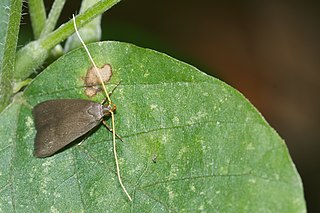
The Lecithocerinae are a subfamily of small moths in the family Lecithoceridae. They are found worldwide, but most species occur in South Asia. The subfamily is characterized by the male genitalia with a bridge-like structure connecting the tegumen and the valva, and the uncus almost always is vestigial with two lobes at the dorsal base, only exceptionally united into a broad plate, but never as a thorn or spine.

Homaloxestis is a genus of moths in the family Lecithoceridae. The genus was erected by Edward Meyrick in 1910.

Lecithocera is a genus of moths in the lecithocerid subfamily Lecithocerinae. The genus was erected by Gottlieb August Wilhelm Herrich-Schäffer in 1853.
Homaloxestis alopecopa is a moth in the family Lecithoceridae. It was described by Edward Meyrick in 1929. It is found on Mindanao in the Philippines.
Homaloxestis hemigastra is a moth in the family Lecithoceridae. It was described by Edward Meyrick in 1931. It is found in Uganda.
Homaloxestis liciata is a moth in the family Lecithoceridae. It was described by Edward Meyrick in 1922. It is found on Java in Indonesia.
Homaloxestis pancrocopa is a moth in the family Lecithoceridae. It was described by Edward Meyrick in 1937. It is found in the former Katanga Province of the Democratic Republic of the Congo.
Homaloxestis plocamandra is a moth in the family Lecithoceridae. It was described by Edward Meyrick in 1907. It is found in Nepal, India, Bhutan, northern Vietnam, Thailand and the Philippines (Luzon).
Homaloxestis queribunda is a moth in the family Lecithoceridae. It was described by Edward Meyrick in 1922. It is found on Java in Indonesia.
Homaloxestis subpallida is a moth in the family Lecithoceridae. It was described by Edward Meyrick in 1931. It is found in Cameroon.
Homaloxestis xylotripta is a moth in the family Lecithoceridae. It was described by Edward Meyrick in 1918. It is found in north-western India and northern Vietnam.
Homaloxestis antibathra is a moth in the family Lecithoceridae. It was described by Edward Meyrick in 1916. It is found in southern India.
Homaloxestis ceroxesta is a moth in the family Lecithoceridae. It was described by Edward Meyrick in 1918. It is found on Java and in southern India.
Homaloxestis cribanota is a moth in the family Lecithoceridae. It was described by Edward Meyrick in 1910. It is found in Assam, India.
Homaloxestis turbinata is a moth in the family Lecithoceridae. It was described by Edward Meyrick in 1910. It is found in Assam, India.
Homaloxestis endocoma is a moth in the family Lecithoceridae. It was described by Edward Meyrick in 1910. It is found in southern India.
Homaloxestis eccentropa is a moth in the family Lecithoceridae. It was described by Edward Meyrick in 1934. It is found in southern China.
Homaloxestis liochlaena is a moth in the family Lecithoceridae. It was described by Edward Meyrick in 1931. It is found in China.
Homaloxestis perichlora is a moth in the family Lecithoceridae. It was described by Edward Meyrick in 1910. It is found on Borneo.
Homaloxestis xanthocharis is a moth in the family Lecithoceridae. It was described by Edward Meyrick in 1929. It is found in the Andaman Islands of India.


